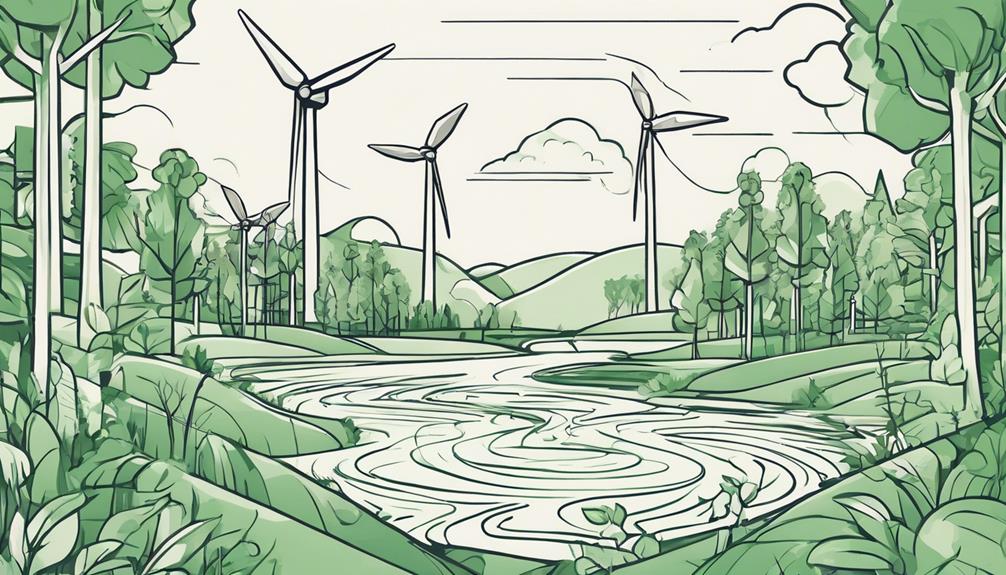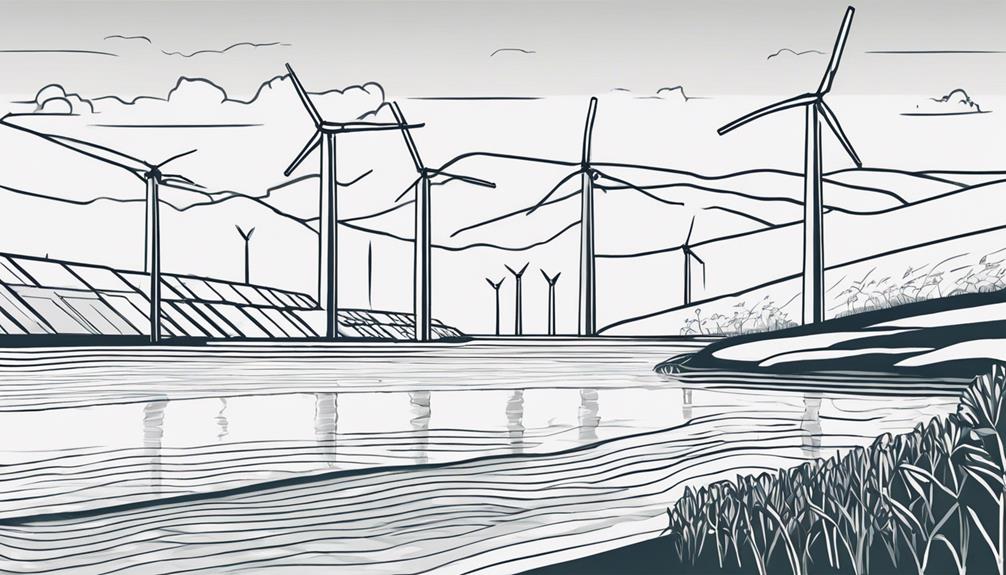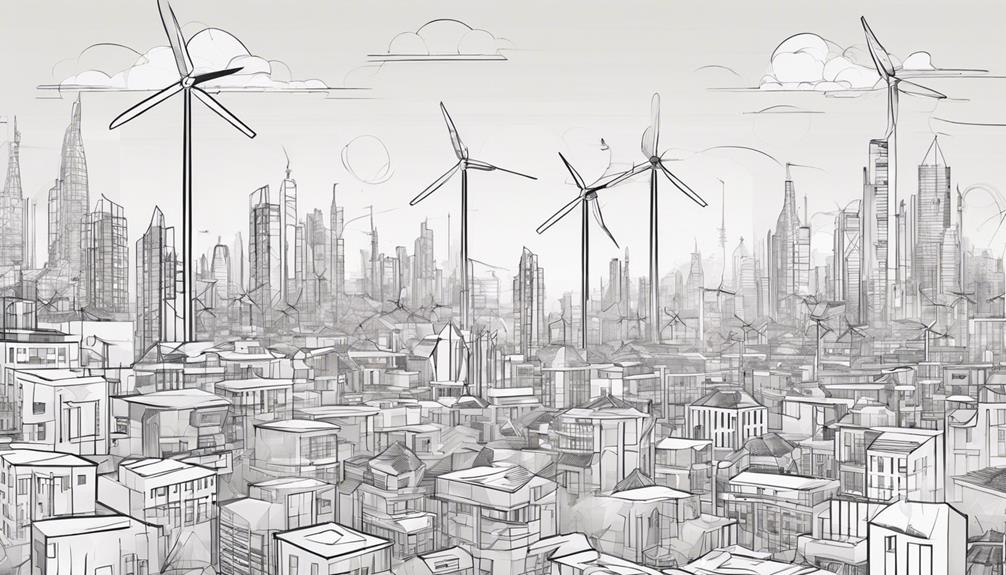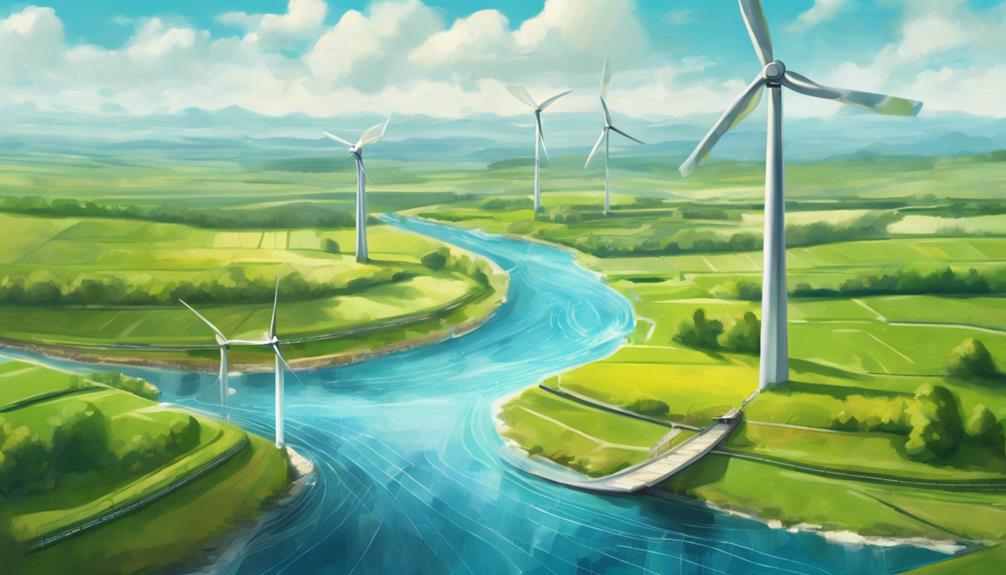Renewable resources are a cornerstone of sustainable energy production, encompassing various natural sources like solar, wind, water, geothermal, and biomass energy. Their ability to be replenished over time distinguishes them from finite fossil fuels. The discussion on renewable resources delves into their significance in mitigating climate change, fostering energy security, and promoting environmental well-being. Understanding the intricacies of these resources is crucial for navigating the complexities of our energy landscape and steering towards a greener future.
Key Takeaways
- Renewable resources naturally replenish, like sunlight and wind.
- They reduce environmental impact and greenhouse gas emissions.
- Vital for energy sustainability and combating climate change.
- Promote innovation, energy security, and a cleaner future.
Definition of Renewable Resources

Renewable resources, also known as replenishable resources, are natural sources that can be naturally restored or regenerated at a rate equal to or greater than their consumption rate. Examples of renewable resources include sunlight, wind, water, geothermal heat, and biomass. These resources are deemed sustainable for long-term use due to their ability to replenish naturally over time, distinguishing them from non-renewable resources that have limited reserves. Sunlight and wind, for instance, are virtually inexhaustible on a human timescale, making them key components in the shift towards renewable energy sources. However, to ensure the continuous availability of renewable resources, conservation efforts are crucial. Sustainable practices and responsible consumption are necessary to maintain the balance between the utilization and renewal of these valuable resources. By harnessing the power of renewable resources while promoting conservation, societies can reduce their dependence on finite, non-renewable sources and move towards a more sustainable energy future.
Importance of Renewable Resources
With the global push towards sustainable energy solutions gaining momentum, the significance of harnessing renewable resources has become increasingly evident in mitigating environmental impacts and ensuring long-term energy security. Renewable resources play a pivotal role in the transition towards sustainable energy production by offering a clean and environmentally friendly alternative to traditional fossil fuels. Sources like solar, wind, and hydropower provide abundant energy that can be harnessed without depleting finite resources. By shifting towards renewable energy sources, countries can reduce their greenhouse gas emissions and lessen their reliance on non-renewable fuels, thus contributing to global efforts to combat climate change.
Moreover, the utilization of renewable resources also helps in achieving net zero goals set by many governments worldwide. Investing in renewable energy not only benefits the environment but also promotes energy security and independence. As the world faces increasing challenges posed by climate change, the importance of embracing clean and sustainable energy sources like solar, wind, and hydropower cannot be overstated.
Common Types of Renewable Resources

The shift towards sustainable energy solutions necessitates a comprehensive understanding of the common types of renewable resources available for energy production. Geothermal power stands out as a renewable resource that harnesses Earth's heat and hot water reservoirs to generate electricity. Biomass energy, on the other hand, utilizes organic materials such as wood, sewage, and ethanol, making it a versatile and sustainable option for energy production. Hydropower is another key player in the realm of renewable resources, generating electricity from the natural flow of water, offering a consistent and reliable source of power. Wind energy, captured through wind turbines, is a clean and abundant energy source that contributes significantly to renewable energy generation. Solar energy, converted into electricity using photovoltaic cells, is a widely adopted renewable resource that holds immense potential for sustainable power production. These common types of renewable resources pave the way for a greener and more sustainable energy future.
Renewable Vs. Non-Renewable Resources
In the realm of energy production and sustainability, the comparison between resources that are renewable and those that are non-renewable is of paramount importance. Renewable resources, such as sunlight, wind, water, geothermal energy, and biomass, provide a sustainable source of energy that replenishes naturally. These sources of renewable energy consumption are key in reducing greenhouse gas emissions and mitigating environmental impact. On the other hand, non-renewable resources like coal, natural gas, and oil are finite, taking millions of years to form and contributing significantly to greenhouse gases.
| Renewable Resources | Non-Renewable Resources | Environmental Impact |
|---|---|---|
| Sunlight | Coal | Reduced greenhouse gas emissions |
| Wind | Natural Gas | Finite reserves |
| Water | Oil | Long formation time |
Utilizing renewable energy production not only helps in reducing environmental impact but also decreases dependency on limited fossil fuel reserves, making it a crucial aspect of sustainable energy development.
Sustainability Benefits of Renewable Resources

Harnessing renewable resources for energy production offers numerous sustainability benefits, including reducing pollution and greenhouse gas emissions. Clean energy sources like solar energy play a crucial role in decreasing our dependence on nonrenewable resources, leading to a healthier environment. By utilizing renewable resources for power generation, we can significantly reduce the carbon footprint associated with traditional energy sources. These sustainable power generation methods not only help in mitigating climate change but also promote energy security due to the abundance of these resources. In 2017, renewable resources accounted for 11% of U.S. energy consumption, showcasing the increasing importance of transitioning towards cleaner energy sources. Embracing renewable resources not only aids in lowering greenhouse gas emissions but also fosters innovation in the energy sector, driving towards a more sustainable future for generations to come.
Government Policies Supporting Renewable Resources
Government policies play a pivotal role in driving the adoption and expansion of renewable resources by providing tax incentives, grants, and subsidies to support clean energy initiatives. These policies aim to shift the energy mix towards sustainable sources by implementing mechanisms such as renewable portfolio standards, feed-in tariffs, and net metering. Renewable portfolio standards mandate a specific portion of electricity to be generated from renewable sources, stimulating investments in renewable energy projects. Feed-in tariffs ensure a fixed payment rate for renewable energy production, incentivizing the establishment of new renewable facilities. Net metering enables individuals to sell surplus renewable energy back to the grid, fostering distributed generation and the growth of renewable energy capacity. Additionally, governments set renewable energy targets to increase the proportion of renewables in the energy matrix, thereby reducing dependency on fossil fuels and advancing towards a cleaner and more sustainable power sector.
Future Outlook for Renewable Resources

The future of renewable resources appears optimistic as a result of the continuous growth and advancements in technology within this sector. With a focus on increasing the efficiency and cost-effectiveness of renewable energy sources, the trajectory is set for a significant role in reducing carbon emissions and addressing climate change challenges. Governmental support and international collaborations further bolster the development and integration of renewable resources into the global energy landscape.
Growth of Renewables
The continued expansion of renewable resources signifies a significant shift towards sustainable energy practices on a global scale. Projections indicate that renewable energy sources are expected to play a more substantial role in global energy consumption, reflecting the increasing investments in cleaner and sustainable energy solutions. Government policies and incentives are driving this growth, encouraging the adoption of renewable technologies. Technological advancements are further enhancing the efficiency of renewable energy sources while simultaneously reducing costs, making them more competitive in the energy market. This transition to renewables is crucial for combating climate change and decreasing reliance on fossil fuels, paving the way for a more sustainable energy future.
Technological Advancements
With the ongoing advancements in renewable resources, the future outlook for sustainable energy production is increasingly promising. Technological innovations are significantly enhancing the efficiency and reliability of energy production from renewable sources. Energy storage systems are addressing the variability of renewable sources, ensuring a more consistent energy supply. Smart grid technologies play a crucial role in optimizing the integration of renewable energy into existing power systems, enabling better management and distribution. Research and development efforts are continuously improving renewable technologies, leading to cost-effective and sustainable energy solutions. Collaborations between industries and governments are driving global growth and deployment of renewable resources, shaping a more environmentally friendly and resilient energy landscape.
| Technological Advancements | Impact on Renewable Resources | Future Implications |
|---|---|---|
| Enhanced efficiency and reliability | Improved energy production | Promising future outlook |
| Energy storage systems addressing variability | Consistent energy supply | Stable renewable energy integration |
| Smart grid technologies optimizing integration | Better management and distribution | Enhanced grid efficiency |
Frequently Asked Questions
What Are 5 Examples of Renewable Resources?
Five examples of renewable resources include solar power, wind energy, hydroelectric power, geothermal energy, and biomass fuel. These sources offer sustainable alternatives for energy production, reducing reliance on finite fossil fuels. Harnessing these resources promotes energy efficiency, sustainable agriculture, and green technology, contributing to climate change mitigation and environmental conservation efforts. Embracing renewable resources is crucial for a greener, more sustainable future.
What Are Renewable Sources?
Renewable sources encompass solar power, wind energy, geothermal heat, hydropower potential, biomass production, and ocean waves. These resources enable sustainable practices through green technology, offering environmental benefits while creating economic opportunities. Solar power capitalizes on sunlight, while wind energy harnesses air movement for electricity. Geothermal heat utilizes Earth's warmth, and hydropower exploits water flow. Biomass production converts organic matter, and ocean waves offer kinetic energy. Embracing renewable sources promotes a sustainable future.
What Are the 7 Types of Renewable Resources?
Solar power, wind energy, geothermal heat, hydroelectric dams, biomass fuel, tidal power – these are the seven types of renewable resources critical to sustainable energy. Each source harnesses natural elements like sunlight, wind, water, and heat to generate power. Embracing renewable energy not only reduces carbon emissions but also promotes sustainable practices like eco-friendly technology and green farming. This shift towards renewable resources is vital for mitigating climate change and ensuring a cleaner, greener future.
What Is Meant by Renewable Resource?
A renewable resource is a natural source of energy that can be replenished over time, contributing to sustainable energy production. These resources play a vital role in reducing our reliance on finite non-renewable sources like coal and oil. Harnessing renewable resources for energy production not only mitigates environmental impact but also ensures sustainable practices for future developments. By utilizing green technology and implementing global initiatives, renewable resources offer economic benefits and alternative solutions in combating climate change.
Conclusion
In conclusion, renewable resources are essential for sustainable energy production, environmental protection, and reducing greenhouse gas emissions. By harnessing natural sources like solar, wind, water, geothermal, and biomass energy, we can move towards a cleaner and healthier future. The contrast between renewable and non-renewable resources highlights the importance of shifting towards sustainable energy sources. Government policies supporting renewable resources are crucial for fostering a more sustainable energy landscape. The future outlook for renewable resources is promising, offering a solution to our energy needs.
